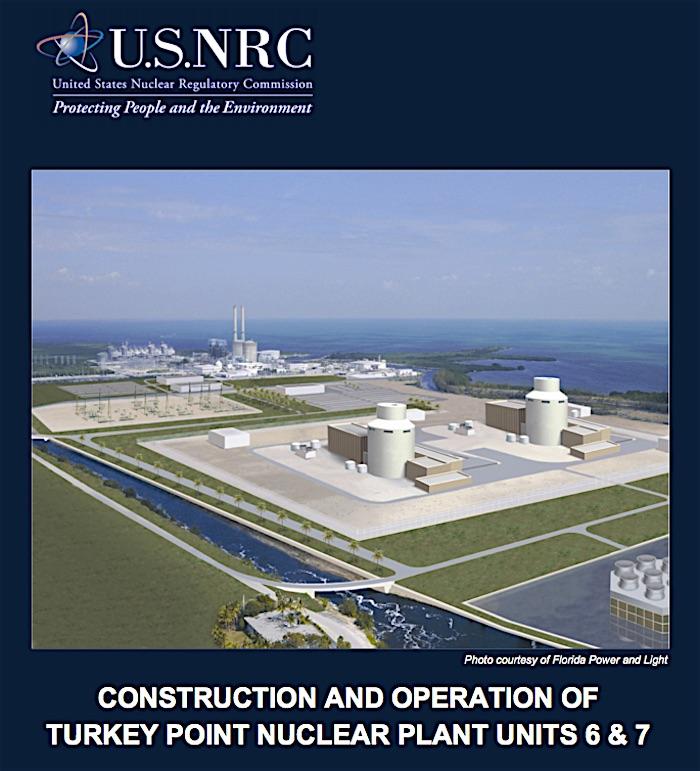
Environmental groups promise to oppose Florida Power & Light's efforts to add two units to its Turkey Point Nuclear Plant near Biscayne and Everglades national parks/NRC
Florida Power & Light, which earlier this year had to deal with water pollution from its Turkey Point Nuclear Power Plant near Biscayne and Everglades national parks, is proposing to add two units to the facility. A review of the plans by the Nuclear Regulatory Commission cited various adverse environmental impacts that could occur, but didn't view any as calamitous.
Among the "unavoidable" environmental impacts the NRC identified in its final Environmental Impact Statement, but which it considered to be "small," were:
- Cooling-tower drift deposition of small amounts of chemical contaminants on portions of Biscayne Bay;
- Transmission lines in urban areas and near the Everglades National Park could conflict with existing land uses. Onsite facilities would be in close proximity to Biscayne National Park.
- Permanent loss of mangroves and other wetland habitats and pine rockland and other upland habitats, habitat fragmentation by pipelines and transmission lines, and increased mortality risk to certain listed species. Rights-of-way maintenance activities in or near wetlands and proposed critical habitat. Increased vehicle collision risk mortality to the Florida panther, vegetation-control effects on listed plants, and transmission system impacts on wood storks and Everglade snail kites.
- Permanent loss of some onsite aquatic environments, some disturbance, and possible disturbance of manatees, Smalltooth Sawfish, Nassau Grouper, and sea turtles. 270 acres of permanent critical habitat loss and 211 acres that would be adversely affected for resident American crocodiles. During limited radial collector well operation, there would not be noticeable increases in salinity above normal background variation. Additional crocodile takes may occur, and cooling-tower drift deposition effects are expected to be minor.
At the National Parks Conservation Association, officials say the proposal "threatens our national parks, endangered wildlife, Everglades restoration and the health of park water resources. According to the NRC’s own standards, 'sites adjacent to lands devoted to public use may be considered unsuitable,' and unacceptable impacts are 'most apt to arise in areas adjacent to natural-resource-oriented areas.' Therefore, Turkey Point should not expand their operations because of its possible impacts to the ecological health and economic viability of surrounding protected areas."
“We have serious concerns about the expansion proposal for Turkey Point, especially considering the widespread contamination the plant’s operations has already caused in nearby water resources," said Caroline McLaughlin, NPCA's Biscayne program manager. "If the expansion moves forward, it would double the number of nuclear towers, all located on the shores of the nation’s largest marine national park.
“You couldn’t pick a worse location to put a nuclear power plant than between two national parks and an area already vulnerable to storm surge and sea level rise. Biscayne and Everglades National Parks are home to threatened species like the wood stork, snail kite and West Indian manatee, and offer amazing recreational opportunities like boating, fishing, scuba diving and exploring," she added in a prepared statement. "Both parks are key components of the ongoing, multibillion-dollar Everglades restoration investment. Collectively they welcome more than 1.5 million visitors that spend around $135 million annually, invigorating South Florida’s local economy."
Back in March, studies commissioned by the state of Florida confirmed that waters discharged from the Turkey Point nuclear power plant were contaminating Biscayne Bay and posed a threat to Biscayne National Park.
At the time, acting-Superintendent Bill Cox said there had not been any measurable impacts to the park, but there was concern that the pollutants could drive algal blooms that would impact the marine life and seagrass beds.
"We don’t have a full picture of what that actually means to the park. We all know what it could mean, in terms of algal blooms," he told the Traveler during a phone call.
As explained by the superintendent, the problems appear to stem from recent drought conditions in South Florida that have forced FP&L to augment the saltwater in its 168 miles of cooling canals with freshwater. That freshwater is forcing the underlying layer of saltwater, which is rich in phosphorous and ammonia, down into the porous karst geology that in turn funnels the pollutants east into Biscayne Bay and west towards public drinking water wells.
While levels of tritium, a radioactive isotope that occurs naturally and also is linked to nuclear reactors, have increased in sampling of the bay waters, reaching 4,000 picocuries per liter in one sample, they are not a great concern, said Superintendent Cox, as they are well below EPA-allowed levels of 20,000 picicuries per liter.
Officials for Florida Power and Light told the Traveler last spring that the situation was under control and not a threat to either the public's drinking water or the national park.
"NPCA, along with the Southern Alliance for Clean Energy and other individuals are challenging FPL's application for a federal license for the two new reactors and are awaiting next steps within the legal process," Ms. McLaughlin said after the NRC issued its EIS. "We will continue to do all that we can to preserve Biscayne and Everglades national parks, their natural resources and our drinking water.”



Add comment